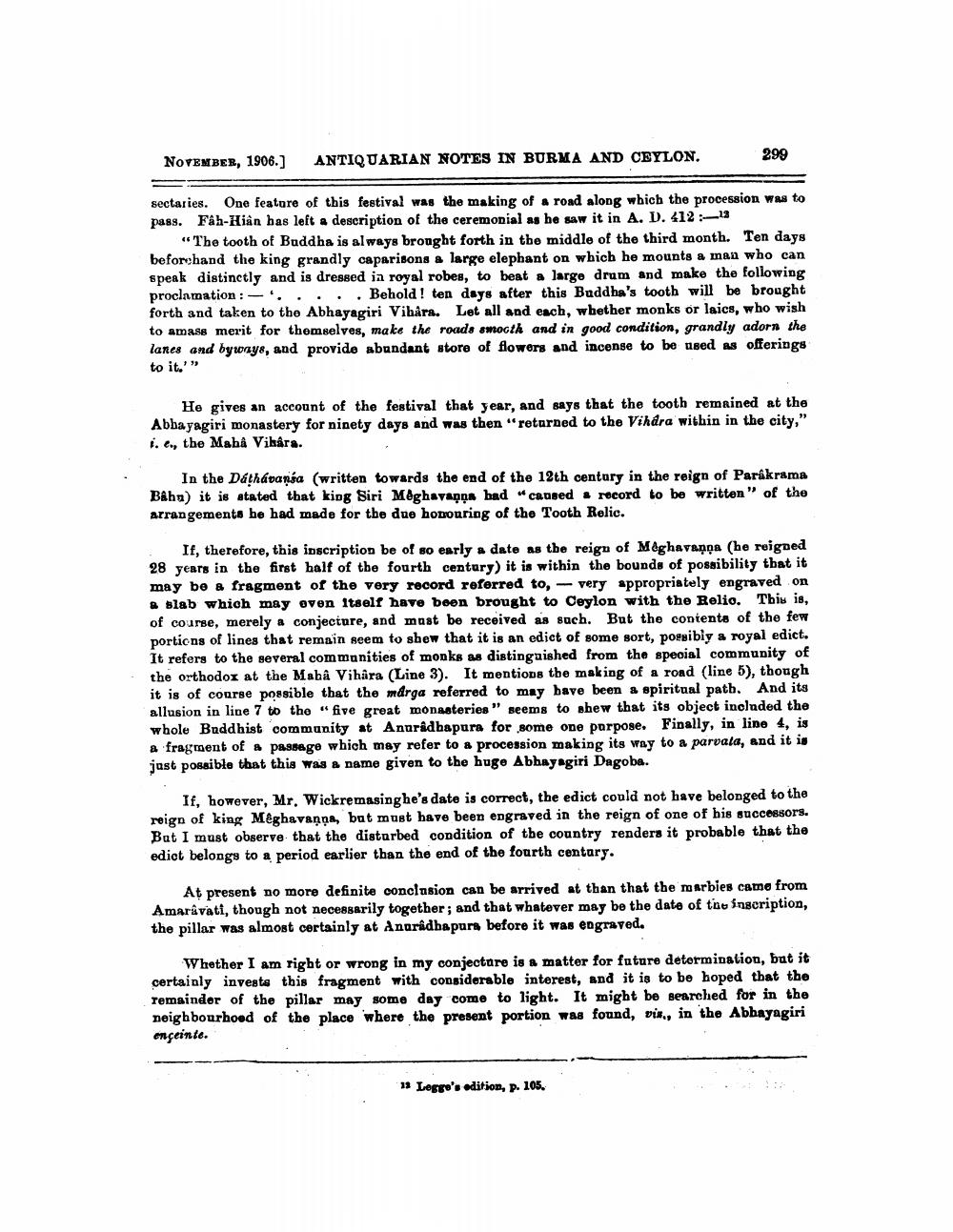________________
NOVEMBER, 1906.)
ANTIQUARIAN NOTES IN BURMA AND CEYLON.
299
sectaries. One feature of this festival was the making of a road along which the procession was to pass. Fåh-Hin has left a description of the ceremonial as he saw it in A. D. 412 413
"The tooth of Buddha is always bronght forth in the middle of the third month. Ten days beforehand the king grandly caparisons a large elephant on which he mounts a man who can speak distinctly and is dressed in royal robes, to beat a largo drum and make the following proclamation : -'..... Behold! ten days after this Buddha's tooth will be brought forth and taken to the Abhayagiri Vihara. Let all and each, whether monks or laics, who wish to amass merit for themselves, make the roads smooth and in good condition, grandly adorn the lanes and by ways, and provide abundant store of flowers and incense to be tied as offerings
to it.'»
He gives an account of the festival that year, and says that the tooth remained at the Abbayagiri monastery for ninety days and was then "returned to the Vihdra within in the city," i. e., the Mabâ Vikárs.
In the Dathavania (written towards the end of the 12th century in the reign of Parakrama Bahn) it is stated that king Siri Méghava na had caused a record to be written" of the arrangements be had made for the due honouring of the Tooth Relic.
If, therefore, this inscription be of so early a date as the reign of Meghavana (he reigned 28 years in the first half of the fourth century) it is within the bounds of possibility that it may be a fragment of the very record referred to, - very appropriately engraved on
blab which may oven itself have been brought to Ceylon with the Relio. This is, of course, merely a conjecture, and must be received as such. But the contents of the few portions of lines that remain seem to shew that it is an edict of some sort, possibly a royal edict. It refers to the several communities of monks as distinguished from the special community of the orthodox at the Maha Vihara (Line 3). It mentions the making of a rond (line 5), though it is of course possible that the marga referred to may bave been a spiritual path. And its allusion in line 7 to the "five great monasteries " seems to shew that its object included the whole Buddhist community at Anuradhapura for some one purpose. Finally, in line 4, is a fragment of passage which may refer to a procession making its way to a parvata, and it is just possible that this was & name given to the huge Abbayagiri Dagoba.
If, however, Mr. Wickremasinghe's date is correct, the edict could not have belonged to the reign of king Mêghavanns, but must have been engraved in the reign of one of his successors. But I must observe that the disturbed condition of the country renders it probable that the edict belongs to a period earlier than the end of the fourth century.
At present no more definite conclusion can be arrived at than that the marbies came from Amaravati, though not necessarily together; and that whatever may be the date of the inscription, the pillar was almost certainly at Anuradhapurs before it was engraved.
Whether I am right or wrong in my conjectare is a matter for future determination, but it certainly invests this fragment with considerable interest, and it is to be hoped that the remainder of the pillar may some day come to light. It might be searched for in the neighbourhood of the place where the present portion was found, vix, in the Abhayagiri enceinte.
1 Logre's edition, p. 105.




